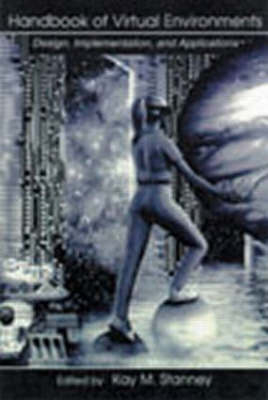
Handbook of Virtual Environments
Lawrence Erlbaum Associates Inc (Verlag)
978-0-8058-3270-9 (ISBN)
- Titel erscheint in neuer Auflage
- Artikel merken
This Handbook, with contributions from leading experts in the field, provides a comprehensive, state-of-the-art account of virtual environments (VE). It serves as an invaluable source of reference for practitioners, researchers, and students in this rapidly evolving discipline. It also provides practitioners with a reference source to guide their development efforts and addresses technology concerns, as well as the social and business implications with which those associated with the technology are likely to grapple. While each chapter has a strong theoretical foundation, practical implications are derived and illustrated via the many tables and figures presented throughout the book.
The Handbook presents a systematic and extensive coverage of the primary areas of research and development within VE technology. It brings together a comprehensive set of contributed articles that address the principles required to define system requirements and design, build, evaluate, implement, and manage the effective use of VE applications. The contributors provide critical insights and principles associated with their given area of expertise to provide extensive scope and detail on VE technology.
After providing an introduction to VE technology, the Handbook organizes the body of knowledge into five main parts:
*System Requirements--specifies multimodal system requirements, including physiological characteristics that affect VE system design.
*Design Approaches and Implementation Strategies--addresses cognitive design strategies; identifies perceptual illusions that can be leveraged in VE design; discusses navigational issues, such as becoming lost within a virtual world; and provides insights into structured approaches to content design.
*Health and Safety Issues--covers direct physiological effects, signs, symptoms, neurophysiology and physiological correlates of motion sickness, perceptual and perceptual-motor adaptation, and social concerns.
*Evaluation--addresses VE usability engineering and ergonomics, human performance measurement in VEs, usage protocols; and provides means of measuring and managing visual, proprioceptive, and vestibular aftereffects, as well as measuring and engendering sense of presence.
*Selected Applications of Virtual Environments--provides a compendium of VE applications.
The Handbook closes with a brief review of the history of VE technology. The final chapter provides information on the VE profession, providing those interested with a number of sources to further their quest for the keys to developing the ultimate virtual world.
Contents: G. Salvendy, Series Foreword. G. Fogelman, Foreword. M. Krueger, Perspective. K.M. Stanney, Preface. Part I:Introduction. K.M. Stanney, M. Zyda, Virtual Environments in the 21st Century. R.A. Blade, M.L. Padgett, Virtual Environments Standards and Terminology. Part II:System Requirements: Hardware Requirements. J.G. May, D.R. Badcock, Vision and Virtual Environments. R.D. Shilling, B. Shinn-Cunningham, Virtual Auditory Displays. S.J. Biggs, M.A. Srinivasan, Haptic Interfaces. C. Basdogan, M.A. Srinivasan, Haptic Rendering in Virtual Environments. B.D. Lawson, S.A. Sides, K.A. Hickinbotham, User Requirements for Perceiving Body Acceleration. E. Foxlin, Motion Tracking Requirements and Technologies. J. Wilder, G.K. Hung, M.M. Tremaine, M. Kaur, Eye Tracking in Virtual Environments. M. Turk, Gesture Recognition. J.M. Hollerbach, Locomotion Interfaces. Software Requirements. G.D. Kessler, Virtual Environment Models. D.A. Bowman, Principles for the Design of Performance-Oriented Interaction Techniques. W.T. Nelson, R.S. Bolia, Technological Considerations in the Design of Multisensory Virtual Environments: The Virtual Field of Dreams Will Have to Wait. J.M. Allbeck, N.I. Badler, Embodied Autonomous Agents. C.E. Hughes, J.M. Moshell, D. Reed, Internet-Based Virtual Environments. Application Requirements. J.R. Wilson, R.M. Eastgate, M. D'Cruz, Structured Development of Virtual Environments. D.B. Kaber, J.V. Draper, J.M. Usher, Influence of Individual Differences on Application Design for Individual and Collaborative Immersive Virtual Environments. C.E. Lathan, M.R. Tracey, M.M. Sebrechts, D.M. Clawson, G.A. Higgins, Using Virtual Environments as Training Simulators: Measuring Transfer. Part III:Design Approaches and Implementation Strategies. A. Munro, R. Breaux, J. Patrey, B. Sheldon, Cognitive Aspects of Virtual Environments Design. G.V. Popescu, G.C. Burdea, H. Trefftz, Multimodal Interaction Modeling. R.L. Storms, Auditory-Visual Cross-Modality Interaction and Illusions. L.J. Hettinger, Illusory Self-Motion in Virtual Environments. R.P. Darken, B. Peterson, Spatial Orientation, Wayfinding, and Representation. J. Isdale, C. Fencott, M. Heim, L. Daly, Content Design for Virtual Environments. D. Gross, Technology Management and User Acceptance of Virtual Environment Technology. R.S. Kennedy, K.E. Kennedy, K.M. Bartlett, Virtual Environments and Product Liability. G.M.P. Swann, R.J. Stone, Virtually a Market? Selling Practice and the Diffusion of Virtual Reality. Part IV:Health and Safety Issues. E. Viirre, D. Bush, Direct Effects of Virtual Environments on Users. B.D. Lawson, D.A. Graeber, A.M. Mead, E.R. Muth, Signs and Symptoms of Human Syndromes Associated With Synthetic Experiences. R.B. Welch, Adapting to Virtual Environments. D.L. Harm, Motion Sickness Neurophysiology, Physiological Correlates, and Treatment. S.L. Calvert, The Social Impact of Virtual Environment Technology. Part V:Evaluation. D. Hix, J.L. Gabbard, Usability Engineering of Virtual Environments. D.R. Lampton, J.P. Bliss, C.S. Morris, Human Performance Measurement in Virtual Environments. K.M. Stanney, R.S. Kennedy, K. Kingdon, Virtual Environment Usage Protocols. J.P. Wann, M. Mon-Williams, Measurement of Visual Aftereffects Following Virtual Environment Exposure. P. DiZio, J.R. Lackner, Proprioceptive Adaptation and Aftereffects. T.A. Stoffregen, M.H. Draper, R.S. Kennedy, D. Compton, Vestibular Adaptation and Aftereffects. W. Sadowski, K.M. Stanney, Presence in Virtual Environments. P.R.M. Bell, Ergonomics in Virtual Environments. Part VI:Selected Applications of Virtual Environments. R.J. Stone, Applications of Virtual Environments: An Overview. B.W. Knerr, R. Breaux, S.L. Goldberg, R.A. Thurman, National Defense. E. Salas, R.L. Oser, J.A. Cannon-Bowers, E. Daskarolis, Team Training in Virtual Environments: An Event-Based Approach. J.M. Moshell, C.E. Hughes, Virtual Environments as a Tool for Academic Learning. S. Cobb, H. Neale, J. Crosier, J.R. Wilson, Development and Evaluation of Virtual Environments for Education. R.M. Satava, S.B. Jones, Medical Applications of Virtual Environments. A. Kheddar, R. Chellali, P. Coiffet, Virtual Environment-Assisted Teleoperation. M.K. Holden, E. Todorov, Use of Virtual Environments in Motor Learning and Rehabilitation. A.A. Rizzo, J.G. Buckwalter, C. van der Zaag, Virtual Environment Applications in Clinical Neuropsychology. M.M. North, S.M. North, J.R. Coble, Virtual Reality Therapy: An Effective Treatment for Psychological Disorders. R.C. Davies, Applications of Systems Design Using Virtual Environments. S. Bryson, Information Visualization in Virtual Environments. J.P. Shewchuk, K.H. Chung, R.C. Williges, Virtual Environments in Manufacturing. E. Badiqué, M. Cavazza, G. Klinker, G. Mair, T. Sweeney, D. Thalmann, N.M. Thalmann, Entertainment Applications of Virtual Environments. Part VII:Conclusion. R.A. Blade, M.L. Padgett, Virtual Environments: History and Profession.
| Erscheint lt. Verlag | 1.1.2002 |
|---|---|
| Reihe/Serie | Human Factors and Ergonomics |
| Verlagsort | Mahwah |
| Sprache | englisch |
| Gewicht | 2177 g |
| Themenwelt | Mathematik / Informatik ► Informatik ► Theorie / Studium |
| ISBN-10 | 0-8058-3270-X / 080583270X |
| ISBN-13 | 978-0-8058-3270-9 / 9780805832709 |
| Zustand | Neuware |
| Haben Sie eine Frage zum Produkt? |
aus dem Bereich



